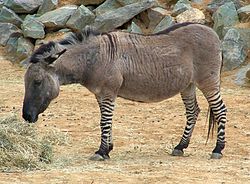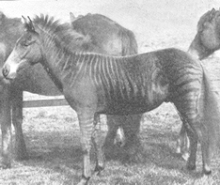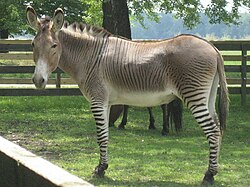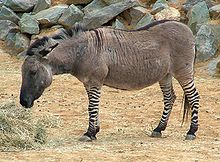User:DiverDave/Zebroid
Small text
| This is not a Wikipedia article: This is a workpage, a collection of material and work in progress that may or may not be incorporated into an article. It should not necessarily be considered factual or authoritative. |

A zebroid (also zebra mule and zebrule) is the offspring of any cross between a zebra and any other equine: essentially, a zebra hybrid. In most cases, the sire is a zebra stallion. Offspring of a donkey sire and zebra mare, called a zebra hinny, do exist but are rare. Zebroids have been bred since the 19th century. The extinct quagga was also crossed with horses and donkeys. Charles Darwin noted several zebra hybrids in his works.
Types[edit]
Zebroid is the generic name for all zebra hybrids. The different hybrids are generally named using the portmanteau convention of sire's name + dam's name. There is generally no distinction made as to which zebra species is used. See individual entries for more information on the different types of zebroid. Many times when Zebras are cross-bred they develop some form of dwarfism.
- Zebra (stallion) + horse (mare): zorse, zebra mule, zebrule or golden zebra
- Zebra (stallion) + pony (mare): zony
- Zebra (stallion) + Shetland pony (mare): zetland
- Zebra (stallion) + any ass species (jenny): zebrass
- Zebra (stallion) + donkey (jenny): zedonk, zeedonk, zonkey, zebronkey, zebadonk
- Zebra (mare) + donkey (jack): zebret, zebrinny
- Zebra (mare) + horse (stallion): hebra, horbra
Genetics[edit]
Zebras, donkeys and horses are equines, and can be crossbred to produce hybrids despite having different numbers of chromosomes. Horses have 64 chromosomes, zebra have between 32 and 44 (depending on species). Most zebroids have 54 chromosomes (44 x 64).
Appearance[edit]
Zebroids physically resemble their non-zebra parent, but are striped like a zebra. The stripes generally do not cover the whole body, and might be confined to the legs or spread onto parts of the body or neck. If the non-zebra parent was patterned (such as a roan, Appaloosa, Pinto horse, paint, piebald, or skewbald) this pattern might be passed down to the zebroid, in which case the stripes are usually confined to nonwhite areas. The alternative name golden zebra relates to the interaction of zebra striping and a horse's bay or chestnut colour to give a zebra-like black-on-bay or black-on-chestnut pattern that superficially resembles the quagga. In zebra-ass hybrids, there is usually a dorsal (back) stripe and a ventral (belly) stripe.
Zebroids are preferred over zebra for practical uses such as riding, because the zebra has a different body shape from a horse or donkey, and consequently it is difficult to find tack to fit a zebra. However, a zebroid is usually more inclined to be temperamental than a purebred horse and can be difficult to handle.
Historical and notable zebroids[edit]

Today, various zebroids are bred as riding and draft animals and as curiosities in circuses and smaller zoos.
- In 1815, Lord Morton mated a quagga stallion to a chestnut Arabian mare. The result was a female hybrid which resembled both parents.
- In Origin of Species (1859), Charles Darwin mentioned four coloured drawings of hybrids between the ass and zebra.
- In his book The Variation of Animals and Plants under Domestication, Darwin described a hybrid ass-zebra specimen in the British Museum as being dappled on its flanks. He also mentioned a "triple hybrid, from a bay mare, by a hybrid from a male ass and female zebra" displayed at London Zoo. This would have required the zebroid sire to be fertile.
- During the South African War, the Boers crossed Chapman's zebras and ponies to use as transport animals. Zebras are resistant to sleeping sickness, whereas pure-bred horses and ponies are not, and it was hoped that the zebra mules would inherit this resistance.
- Grevy's Zebra has been crossed with the Somali Ass in the early 20th century.
- Zorses were bred by the US Government and reported in Genetics in Relation to Agriculture by E. B. Babcock and R. E. Clausen (early 20th century), in an attempt to investigate inheritance and telegony.
- A New York Times article from June 16, 1973, mentioned the birth of a cross between a zebra and a donkey at the Jerusalem Zoo. They called it a "hamzab."
- In the 1970s, the Colchester Zoo, England bred zedonks, at first by accident and later to create a disease-resistant riding and draft animal. The experiment was discontinued when zoos became more conservation-minded.
- In 2005, a Burchell's zebra mare named Allison produced a zebra hinny called Alex sired by a donkey at Highland plantation in St. Thomas Parish, Barbados. This is notable as the zebra is usually the sire.
- In 2007, a stallion, Ulysses, and a zebra mare, Eclipse, produced a zebroid named Eclyse, displaying an unusually patchy color coating.[1][2]
References[edit]
- ^ Amanda Billner. "Zebran är en häst" (in Swedish). Dagens Nyheter's webpage, 28 June 2007. Retrieved 30 juni 2007.
- ^ BBC "Half horse, half zebra - hebra Retrieved 3 July 2007]
External links[edit]
- Hybrid Equines Information and images of different zebroids
- Eclyse - Photo of a zebroid named Eclyse
A zony is the offspring of a zebra stallion and a pony mare. Medium size pony mares are preferred in order to produce riding zonies, but zebras have been crossed with smaller pony breeds such as the Shetland resulting in so-called "Zetlands". It is a zebroid: this term refers to any hybrid equine with zebra ancestry.[1]
Cossar Ewart, Professor of Natural History at Edinburgh (1882–1927) and a keen geneticist, crossed a zebra stallion with pony mares in order to investigate the theory of telegony, or paternal impression. His interest had been provoked by the famous zebra/horse hybrids bred by Lord Morton in 1815 from a chestnut 7/8ths Arabian mare and a quagga stallion.
In "Origin of Species" (1859) Charles Darwin wrote that "In Lord Morton's famous hybrid from a chestnut mare and male quagga, the hybrid, and even the pure offspring subsequently produced from the mare by a black Arabian sire, were much more plainly barred across the legs than is even the pure quagga."
During the South African War, the Boers crossed the Chapman's zebra with the pony, to produce an animal for transport work, chiefly for hauling guns. A specimen was captured by British forces and presented to King Edward VII by Lord Kitchener, and was photographed by W S Berridge.[2]
Similar experiments had been carried out in the United States by mating a mare with a zebra stallion. The experiments were reported in Genetics in Relation to Agriculture by E B Babcock and RE Clausen. They were also reported in The Science of Life by H G Wells, J Huxley and GP Wells (c. 1929).
References[edit]
- ^ Carter, Helen (June 27, 2001). "Crisis-hit farm welcomes its gift forse". Guardian Unlimited. London. Retrieved April 20, 2010.
it could be a zorse perhaps, a fony or maybe a shebra or a zetland. Whatever its name, the arrival of the strange beast has been hailed as a godsend
{{cite journal}}: More than one of|work=and|journal=specified (help) - ^ Wonders of Animal Life, edited by J A Hammerton (1930)
External links[edit]
| Zorse | |
|---|---|

| |
| A zorse in an 1899 photograph from J.C. Ewart's The Penycuik Experiments. "Romulus: one year old." | |
| Scientific classification | |
| Kingdom: | |
| Phylum: | |
| Class: | |
| Order: | |
| Family: | |
| Genus: | |
| Species: | E. zebra × caballus
|
| Binomial name | |
| Equus zebra × Equus caballus | |

A zorse is a zebroid, specifically the offspring of a zebra stallion and a horse mare. The rarer reverse pairing is sometimes called a horbra (or hebra). Like most other animal hybrids, the zorse is sterile.[1]
The zorse is a strong animal with traits from both its parents.
James Cossar Ewart crossed a zebra stallion with horse and pony mares in order to investigate the theory of telegony, or paternal impression. Cossar Ewart used Arabian mares. Similar experiments were carried out by the US Government and reported in "Genetics in Relation to Agriculture" by E.B. Babcock and R.E. Clausen, and in "The Science of Life" by H.G. Wells, J. Huxley and G.P. Wells (c.1929).
Zorses are bred in Africa and used for trekking on Mount Kenya;[2] the zebra parent gives resistance to the nagana pest disease.
Coloration[edit]
Zorses combine the zebra striping overlaid on colored areas of the hybrid's coat. Zorses are most often bred using solid color horses. If the horse parent is piebald (black and white) or skewbald (other color and white) (these are known in the United States as paint/pinto) the zorse may inherit the dominant de-pigmentation genes for white patches, it is understood that Tobiano (the most common white modifier found in the horse) directly interacts with the Zorse coat to give the white markings. Only the non-depigmented areas will have Zebra striping, resulting in a zorse with white patches and striped patches. This effect is seen in the zebroid Eclyse (a hebra rather than a zorse) born in Stukenbrock, Germany in 2007 to a zebra mare called Eclipse and a stallion called Ulysses.
Zorses and humans[edit]
Zorses are preferred over zebras for riding and draught for several reasons, although they are still not as easily handled as horses and should not be ridden or purchased by novices. Their more horselike shape, particularly in the shoulder region, makes it easier to obtain harness that fits correctly.
Zebras, being wild animals, and not domesticated like horses and donkeys, pass on their wild animal traits to their offspring. Zebras, while not usually very large, are extremely strong and aggressive. Similarly, zorses have a strong temperament and can be aggressive.
Notable zorses[edit]
A zorse (more accurately a zony) was born at Eden Ostrich World, Cumbria, England in 2001 after a zebra was left in a field with a Shetland pony. It was referred to as a Zetland. This was the inspiration for the 2003 'Song For the Zorse' by London band The Coronets. According to local lore brown zorses have been spotted in the foot hills of the Appalachians in and around Charlottesville, Virginia.
Zorses have appeared in several TV shows and movies. In the Viva La Bam episode Groundhogs Day in the final race, Brandon Dicamillo's sled is a Zorse. It was colored pink, blue, purple and red and on the 'uncommentary' on the DVD seasons of 'Viva La Bam' Tim Glomb says "If you send me a list of all the episodes where the Zorse is I'll give you a dollar". Also, the 2007 movie I'm Reed Fish features a zorse named Zabrina. In the movie Racing Stripes, an animated zorse appears in the alternate ending. It is the son of Stripes (a zebra) and Sandy, a grey Arabian mare.
Zorses have also appeared in books. They are briefly mentioned several times in George R.R. Martin's A Song of Ice and Fire series of fantasy novels. Sutton Coleman wrote a sonnet about Zorses and published it in his 2007 book, "Ligers, Tigons, and Zorses, Oh My!"
In Roald Dahl's book Going Solo, he and several other characters speculate on how nice it would be to own a zorse, although they admit it would be difficult to train.
References[edit]
- ^ "Zorse Breed Description". Breeding References. EquinePost. Retrieved 2009-05-27.
- ^ "Meet Eclyse - the amazing zebra crossing". Mail Online. Associated Newspapers Ltd. Retrieved 2008-07-10.
- BBC News (26 June 2001): "Zebra Hybrid is Cute Surprise"
- Metro (28 June 2007): "A single-zorsed story"
External links[edit]
- The International Zebra Zorse Zonkey Association
- Zorseman.com
- Zebra/Horse Hybrids
- Video of a Zorse
- Newsvideo of a Zorse (German)
| Zonkey | |
|---|---|

| |
| Scientific classification | |
| Kingdom: | |
| Phylum: | |
| Class: | |
| Order: | |
| Family: | |
| Genus: | |
A zonkey is a cross between a zebra and a donkey. The generic name for crosses between zebras and horses or asses is zebroid or zebra mule. "Zonkey" is not the technically correct name for such a cross. The most commonly accepted terms are zebrinny, zebrula, and zedonk. Donkeys are closely related to zebras and both animals belong to the horse family. Zonkeys are very rare.[1]
In South Africa they occur where zebras and donkeys are found in proximity to each other. Like mules, however, they are genetically unable to breed, due to an odd number of chromosomes disrupting meiosis. However, in The Origin of Species, Charles Darwin reported a case of a zonkey that apparently bred with a bay mare to produce a "triple hybrid".
Usually a zebra stallion is paired with a horse mare or ass mare, but in 2005, a Burchell's Zebra named Allison produced a zonkey called Alex sired by a donkey at Highland plantation in the parish of Saint Thomas, Barbados. Alex, born April 21, 2005, is apparently the first zonkey in Barbados.[2]
Breeding of different branches of the equine family, which does not occur in the wild, results in infertile offspring. The combination of sire and dam also affects the offspring. A zebrinny is the offspring of a male horse and a female zebra; a zebrula is the offspring of a male zebra and a female horse; a zedonk is the offspring of any zebra and any donkey.
A number of hybrids, described as Zeedonks, were kept at Colchester Zoo, the product of accidental mating; the last died in 2009.[3] One adult and a foal remain at the tourist attraction of Groombridge Place [4] near Tonbridge in Kent.
The Wild Animal Safari in Springfield, MO has several zedonks as of March 31, 2010.
Genetics[edit]

Donkeys and wild equids have different numbers of chromosomes. A donkey has 62 chromosomes; the zebra has between 32 and 46 (depending on species). In spite of this difference, viable hybrids are possible provided the gene combination in the hybrid allows for embryonic development to birth. A hybrid has a number of chromosomes somewhere in between. The chromosome difference makes female hybrids poorly fertile and male hybrids sterile due to a phenomenon called Haldane's Rule. The difference in chromosome number is most likely due to horses having 2 longer chromosomes that contain similar gene content to 4 zebra chromosomes.[5]
Common wisdom states that hybrids only occur when the zebra is the sire, but the Barbados hybrid demonstrates otherwise. Two other known zebra hinnies have been foaled but did not survive to adulthood. The rarity of zebra hinnies indicates that the smaller number of chromosomes must generally be on the male side if a viable hybrid is to be produced. Before this comes into account, a successful mating needs to be accomplished in the first place though: As courtship in horses involves the mare kicking at the stallion's head for some time before allowing him to mount, and as this behavior is stronger in wild equids than in domestic horses, it is difficult enough to get a horse stallion to mate and not be put off by the rough behavior of the non-horse mare.
Zonkeys are interspecific hybrids bred by mating together two species from within the same genus. The offspring have traits and characteristics of both parents. Zonkeys vary considerably depending on how the genes from each parent are expressed and how they interact.
See also[edit]
References[edit]
- ^ Megersa, B.; Biffa, D.; Kumsa, B. (2006). "A mysterious zebra-donkey hybrid (zedonk or zonkey) produced under natural mating: A case report from Borana, southern Ethiopia". Animal Production Research Advances. 2 (3): 148–154.
{{cite journal}}: CS1 maint: multiple names: authors list (link) - ^ "Call it zonkey or a deebra? Zebra has a foal sired by a donkey". MSNBC. Associated Press. 29 Apr 2005. Retrieved on October 13, 2008.
- ^ "Colchester Zoo mourns the loss of Shadow the Zeedonk" (Press release). Colchester Zoo. 2009-04-03.
- ^ "The Enchanted Forest". Groombridge Place Gardens.
- ^ K. Benirschke; et al. (1964). "Chromosome Studies of a Donkey-Grevy Zebra Hybrid". Chromosoma. 15 (1).
{{cite journal}}: Explicit use of et al. in:|author=(help)
External links[edit]
- "Zenkey foal a hybrid star". Sydney Morning Herald. Agence France-Presse. 29 Aug 2003.
- "Hybrid Equines". messybeast.com. Photos of ass-zebras from the 1930s.
[[:Category:Equid hybrids]] [[:Category:Donkeys]]
